The Drug Free Depression Treatment Market is estimated to be valued at USD 4.3 billion in 2025 and is projected to reach USD 5.6 billion by 2035, registering a compound annual growth rate (CAGR) of 2.7% over the forecast period.
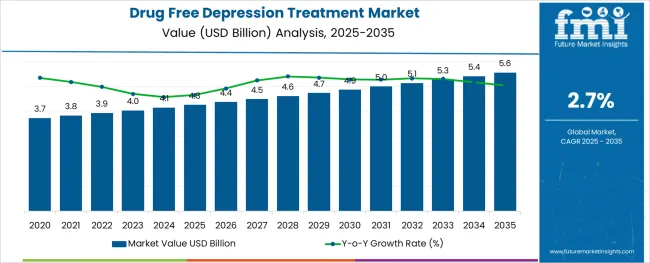
The drug free depression treatment market is growing steadily as more healthcare providers and patients seek alternatives to pharmacological therapies. Mental health awareness campaigns and evolving treatment guidelines have encouraged the adoption of non-drug approaches to managing depression. Increased investment in mental health infrastructure, especially within hospitals and specialized care centers, has supported the expansion of therapeutic services such as counseling and behavioral therapies.
Advances in psychological research have strengthened the evidence base for cognitive and behavioral treatments, improving their acceptance among clinicians and patients alike. The integration of telehealth and digital platforms has further broadened access to drug free treatment options.
As healthcare systems worldwide prioritize holistic and patient-centric mental health care, this market is expected to grow, driven by increasing demand in hospital settings and other healthcare facilities. Segmental growth is expected to be led by cognitive behavioral therapy as the preferred treatment type and hospitals as the primary facility type.
The market is segmented by Treatment Type and Facility Type and region. By Treatment Type, the market is divided into Cognitive Behavioral Therapy, Transcranial Magnetic Stimulation, Herbal Remedies, Acupuncture, Reflexography, Guided Imagery, and Others. In terms of Facility Type, the market is classified into Hospitals, Specialized Clinics, and Rehabilitation Centers. Regionally, the market is classified into North America, Latin America, Western Europe, Eastern Europe, Balkan & Baltic Countries, Russia & Belarus, Central Asia, East Asia, South Asia & Pacific, and the Middle East & Africa.
The market is segmented by Treatment Type and Facility Type and region. By Treatment Type, the market is divided into Cognitive Behavioral Therapy, Transcranial Magnetic Stimulation, Herbal Remedies, Acupuncture, Reflexography, Guided Imagery, and Others. In terms of Facility Type, the market is classified into Hospitals, Specialized Clinics, and Rehabilitation Centers. Regionally, the market is classified into North America, Latin America, Western Europe, Eastern Europe, Balkan & Baltic Countries, Russia & Belarus, Central Asia, East Asia, South Asia & Pacific, and the Middle East & Africa.
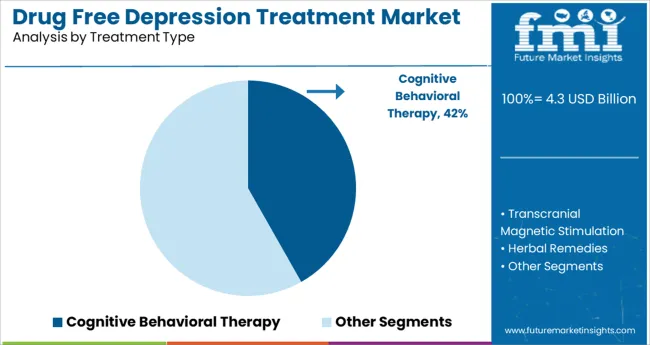
The Cognitive Behavioral Therapy segment is projected to hold 41.8% of the drug free depression treatment market revenue in 2025, reflecting its leading role among treatment modalities. This therapy has gained prominence due to its structured approach that helps patients identify and modify negative thought patterns contributing to depression.
The effectiveness of cognitive behavioral therapy has been supported by extensive clinical studies demonstrating improvements in mood and coping skills without the side effects associated with medication. Mental health practitioners have increasingly incorporated it into treatment plans due to its adaptability across various patient populations and depression severities.
Furthermore, the scalability of this therapy through individual sessions, group formats, and digital platforms has enhanced its accessibility. As patient preference for non-drug treatments grows, cognitive behavioral therapy is expected to remain the cornerstone of drug free depression management.
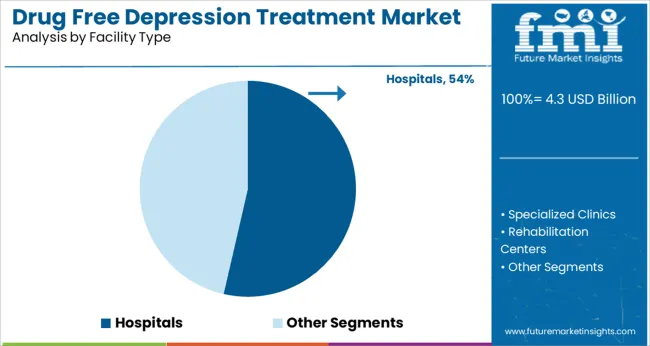
The Hospitals segment is projected to contribute 53.6% of the market revenue in 2025, positioning it as the leading facility type for drug free depression treatments. Hospitals have been central to expanding access to these therapies due to their comprehensive mental health departments and multidisciplinary teams.
The structured environment of hospitals allows for integrated care combining therapy with medical oversight, ensuring patient safety and treatment adherence. Investments in training mental health professionals and incorporating evidence-based protocols have strengthened hospital capabilities in delivering cognitive behavioral therapy and other drug free interventions.
Additionally, hospitals serve a diverse patient base including acute, chronic, and post-discharge populations who benefit from non-pharmacological approaches. With growing emphasis on holistic mental health care and the reduction of medication dependency, hospitals are expected to continue driving market growth in this segment.
Rising prevalence of depression and anxiety due to changing lifestyle and aging, growing awareness among people regarding the availability of alternative depression options, and various benefits associated with drug free depression treatment are some of the major factors driving the growth in drug free depression treatment market.
There is no denying the fact that medication is the quickest and most effective way for relieving the symptoms and treating mental disorders like depression. However, consumption of depression drugs leads to various mild to severe side effects.
Growing awareness among people regarding the adverse side effects of consuming depression drugs is gradually bringing drug free depression treatments like cognitive behavioral therapy, transcranial magnetic stimulation, herbal remedies, and guided imagery, into the spotlight.
Drug free depression treatments are effective for treating depression and several other mental disorders to a large extent. These treatments have minimum side effects which makes them ideal for adoption.
Increasing incidence of depression and other mental disorders is anticipated to continue boosting the growth of drug free depression treatment market during the forecast period. According to the World Health Organization (WHO), around 280 million people in the world have depression and this number is expected to further surge during the forthcoming years.
Similarly, various initiatives and awareness campaigns launched by government and health organizations like Anxiety and Depression Association of America about the drug free depression treatment will further propel the growth of drug free depression treatment market in future
Although drug free depression treatments are gradually gaining traction, there are various factors that are acting as restraints for market growth. Some of these factors are the lack of awareness among people about the alternative treatment options of depression and high cost of drug free depression treatments as compared to drug treatment.
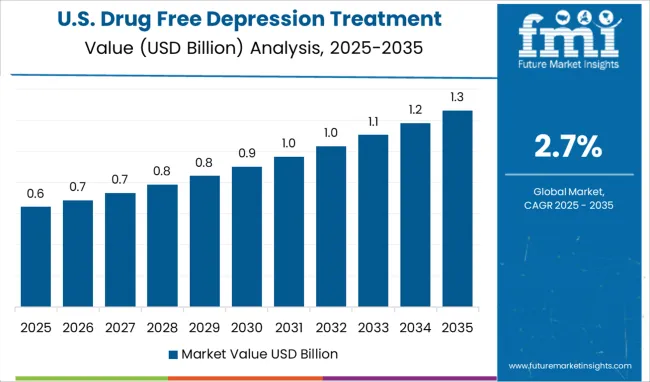
North America was the largest market for drug free depression treatments in 2025 and the trend is likely to pertain during the forecast period, owing to the high levels of health awareness of people, availability of favorable reimbursement policies, and increasing adoption of drug free depression treatments across countries like the U.S. and Canada.
The U.S. remains one of the leading destinations for drug free depression treatments like cognitive behavioral therapy and transcranial magnetic stimulation due to increasing prevalence of mental health disorders. People across the country spend large amounts for the treatment of mental health problems.
Moreover, presence of a well-established healthcare sector along with increasing government initiatives to reduce the burden of mental health disorders, and growing popularity of non-medicine treatments due to minimal side effects will continue to favor the growth of drug free depression treatment market across the region.
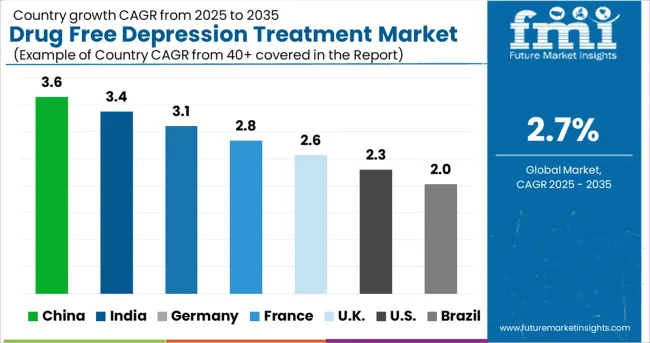
According to Future Market Insights, Asia-Pacific is expected to emerge as the fastest growing region for drug free depression treatment market owing to the growing popularity of herbal medicine in countries like in India, Japan, and China, rising health awareness among people, and large presence of leading market players.
Emerging nations such as China and India are witnessing huge upsurge in the cases of depression and anxiety due to rapidly increasing geriatric population and lifestyle problems. This in turn is creating growth potential for drug free depression treatment market and the trend is likely to continue in the future,
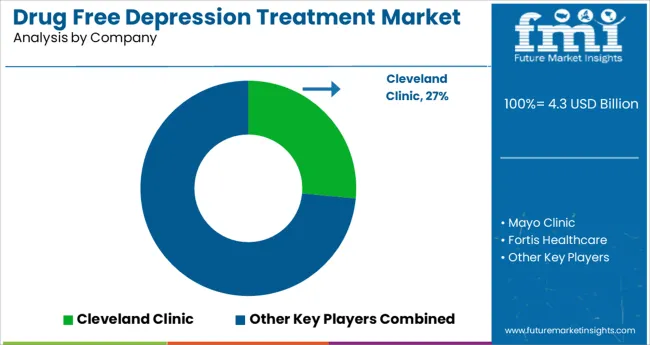
Some of the key participants present in the global drug free depression treatment market include Cleveland Clinic, Mayo Clinic, Fortis Healthcare, Assurex Health, Inc., Great Oaks Recovery Center, McLean Hospital among others.
These key players are adopting various organic and inorganic growth strategies such as partnerships, collaborations, new product launches, and acquisitions to gain a competitive edge in the market. Besides this, they are continuously launching awareness programs and campaigns to educate people about the benefits of using drug free depression treatment for mental disorders.
| Report Attribute | Details |
|---|---|
| Growth Rate | CAGR of 2% to 4% from 2025 to 2035 |
| Base Year for Estimation | 2024 |
| Historical Data | 2020 to 2024 |
| Forecast Period | 2025 to 2035 |
| Quantitative Units | Revenue in billion, Volume in Kilotons and CAGR from 2025 to 2035 |
| Report Coverage | Revenue Forecast, Volume Forecast, Company Ranking, Competitive Landscape, Growth Factors, Trends and Pricing Analysis |
| Segments Covered | Treatment Type, Facility Type, Region |
| Regions Covered | North America; Latin America; Western Europe; Eastern Europe; APEJ; Japan; Middle East and Africa |
| Key Countries Profiled | USA, Canada, Brazil, Argentina, Germany, UK, France, Spain, Italy, Nordics, BENELUX, Australia & New Zealand, China, India, ASEAN, GCC, South Africa |
| Key Companies Profiled | Cleveland Clinic; Mayo Clinic; Fortis Healthcare; Assurex Health, Inc.; Great Oaks Recovery Center; McLean Hospital |
| Customization | Available Upon Request |
The global drug free depression treatment market is estimated to be valued at USD 4.3 billion in 2025.
It is projected to reach USD 5.6 billion by 2035.
The market is expected to grow at a 2.7% CAGR between 2025 and 2035.
The key product types are cognitive behavioral therapy, transcranial magnetic stimulation, herbal remedies, acupuncture, reflexography, guided imagery and others.
hospitals segment is expected to dominate with a 53.6% industry share in 2025.






Full Research Suite comprises of:
Market outlook & trends analysis
Interviews & case studies
Strategic recommendations
Vendor profiles & capabilities analysis
5-year forecasts
8 regions and 60+ country-level data splits
Market segment data splits
12 months of continuous data updates
DELIVERED AS:
PDF EXCEL ONLINE
Drug Taste Masking Technologies Market Forecast and Outlook 2025 to 2035
Drug-Gene Interaction Panels Market Size and Share Forecast Outlook 2025 to 2035
Drug Testing Systems Market Size and Share Forecast Outlook 2025 to 2035
Drug Tester Market Size and Share Forecast Outlook 2025 to 2035
Drug Device Combination Products Market Size and Share Forecast Outlook 2025 to 2035
Drug Discovery Enzymes Market Size and Share Forecast Outlook 2025 to 2035
Drug Integrated Polymer Fibers Market Size and Share Forecast Outlook 2025 to 2035
Drug Discovery Outsourcing Market Size and Share Forecast Outlook 2025 to 2035
Drug Formulation Market Analysis - Size, Growth, & Forecast Outlook 2025 to 2035
Drug-Induced Dyskinesia Market Size and Share Forecast Outlook 2025 to 2035
Drug Delivery Technology Market is segmented by route of administration, and end user from 2025 to 2035
Drugs Glass Packaging Market Analysis - Size, Share, and Forecast Outlook 2025 to 2035
Drug Delivery Solutions Market Insights - Growth & Forecast 2025 to 2035
Drug Designing Tools Market Growth – Trends & Forecast 2025 to 2035
Drug of Abuse Testing Market Growth – Trends & Forecast 2025-2035
Drug-Induced Immune Hemolytic Anemia Market - Demand & Forecast 2025 to 2035
Drug Discovery Services Market Insights - Trends & Growth 2025 to 2035
Drug Screening Market Overview - Trends, Demand & Forecast 2025 to 2035
Drug Discovery Informatics Market Trends - Growth & Future Outlook 2025 to 2035
Drug Testing Equipment Market

Thank you!
You will receive an email from our Business Development Manager. Please be sure to check your SPAM/JUNK folder too.
Chat With
MaRIA